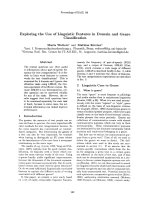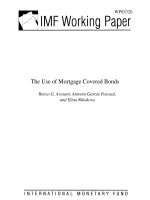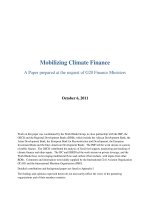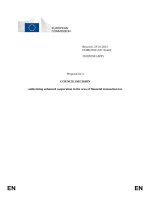WP/07/20 The Use of Mortgage Covered Bonds potx
Bạn đang xem bản rút gọn của tài liệu. Xem và tải ngay bản đầy đủ của tài liệu tại đây (784.27 KB, 23 trang )
WP/07/20
The Use of Mortgage Covered Bonds
Renzo G. Avesani, Antonio García Pascual,
and Elina Ribakova
© 2007 International Monetary Fund WP/07/20
IMF Working Paper
Monetary and Capital Markets
The Use of Mortgage Covered Bonds
Prepared by Renzo G. Avesani, Antonio Garcia Pascual, and Elina Ribakova
1
Authorized for distribution by David D. Marston
January 2007
Abstract
This Working Paper should not be reported as representing the views of the IMF.
The views expressed in this Working Paper are those of the author(s) and do not necessarily represent
those of the IMF or IMF policy. Working Papers describe research in progress by the author(s) and are
published to elicit comments and to further debate.
The rapid mortgage credit growth experienced in recent years in mature and emerging countries has
raised some stability concerns. Many European credit institutions in mature markets have reacted
by increasing securitization, particularly via mortgage covered bonds. From the issuer’s
perspective, these instruments have become an attractive funding source and a tool for asset-
liability management; from the investor’s perspective, covered bonds enjoy a favorable risk-return
profile and a very liquid market. In this paper, we examine the two largest “jumbo” covered bond
markets, Germany and Spain. We show how movements in covered bond prices can be used to
analyze the credit developments of the underlying issuer and the quality of its mortgage portfolio.
Our analysis also suggests that mortgage covered bonds could be of interest to other mature and
emerging markets facing similar risks related to mortgage credit.
JEL Classification Numbers: G10, G21.
Keywords: Mortgage covered bonds, asset swap spreads, market based indicators.
Author
’s E-Mail Address: ; ;
1
We are grateful to colleagues in the Monetary and Capital Markets department of the IMF for valuable comments
and suggestions. Any remaining errors are our own.
2
Contents Page
I. Introduction 3
II. The European Mortgage Covered Bond Market 4
III. Assessing the Credit Risk of Covered Bonds via Asset Swap Spreads 7
IV. The Jumbo Covered Bond Market: The German Pfandbriefe and the Spanish Cédulas
Hipotecarias 9
A. The German Mortgage Pfandbriefe 9
B. The Spanish Cédulas Hipotecarias 10
V. Conclusions 13
Figures
1. Outstanding Volume of German Jumbo Mortgage Pfandbriefe and 5
2. Covered Bond Legislation Across European Markets 6
3. Different Measures of Credit Risk 8
4. Asset Swap Spreads of Jumbo Mortgage Pfandbriefe 10
5. Cédulas Hipotecarias: Overcollateralization of the Largest Four Credit Institutions 11
6. Club Funding with Cédulas Hipotecarias 11
7: Asset Swap Spreads of Jumbo Cédulas Hipotecarias 12
Appendixes
I: Asset Swap Calculation: an Application to Spanish Covered Bonds 16
II: Regulatory Framework for Pfandbriefe and Cédulas Hipotecarias 20
References
References 15
3
I. INTRODUCTION
Rapid mortgage growth over the last few years has been driven by demand and supply
factors and has changed financial markets in mature and emerging countries alike.
2
From the
demand side, favorable macroeconomic conditions, falling interest rates, and international
diversification of investments played an important role. On the supply side, increased
competition, decreasing interest rates and low demand for corporate debt, were important
factors behind banks’ redirection towards higher-margin mortgage lending for diversification
of income.
The rapid mortgage credit growth has raised financial stability concerns for banks and their
supervisors.
3
For banks, low interest rates made it more difficult to attract deposits, creating
the need to find alternative stable sources of non-core-deposit funding. In addition,
lengthening of banks’ asset duration stemming from mortgage lending, created liquidity and
maturity risks. The funding risks became more acute for smaller banks as they had fewer
opportunities to access stable non-deposit funding. In addition to the liquidity and maturity
risks, the supervisors became increasingly concerned about the credit risk of mortgage
portfolios.
In this paper we analyze how securitization via mortgage covered bonds has helped banks in
developed markets to mitigate the risks related to mortgage lending. Securitization has
important benefits for both issuers and investors. From the issuer’s perspective, mortgage
covered bonds have gained predominance as an alternative stable funding source and as an
asset-liability management tool. In terms of risk/return profile, mortgage covered bonds are
attractive for international investors relative to sovereign and corporate debt, especially as the
fiscal stance of some European governments deteriorated and corporate troubles emerged on
both sides of the Atlantic. The substantial development of new securitization tools over the
last 5 years has taken place while markets were looking for long duration, high quality assets.
We then argue that the development of these securitization markets has also permitted a
greater transparency in the evaluation of the credit quality of banks’ portfolios. First, through
securitization, portions of the banks’ loan portfolios are priced by the market. Second, while
these markets become more liquid, the prices of the securitization bonds quoted in the
secondary markets can provide more precise indications of the evolving credit quality of the
underlying portfolio. The “jumbo” or benchmark issues of European mortgage covered bonds
are good candidates for such an analysis, given the size and liquidity of their secondary
market. There are several ways to monitor the dynamics of these markets. In this paper, we
evaluate the dynamics of the asset swap spreads as we believe that this is an appropriate tool
to assess their credit risk.
4
2
BIS (2006); for overview of emerging European countries see Enoch and Ötker-Robe (2006).
3
BIS (2006).
4
This type of analysis was already used as an IMF surveillance tool; see IMF Technical Note (2006).
4
The remainder of this paper is structured as follows. Section II provides a description of
European mortgage covered bonds as well as the main features of the two largest jumbo
covered bond markets: Germany and Spain. Section III shows how to assess the credit risk of
mortgage covered bonds by analyzing their asset swap spreads. Section IV applies this
methodology to analyze the German and Spanish jumbo covered bond markets. Finally, in
Section V we conclude with some recommendations for other markets on the use of
mortgage covered bonds and their risk-mitigating features.
II. THE EUROPEAN MORTGAGE COVERED BOND MARKET
Covered bonds are debt instruments secured against a pool of mortgages to which the
investor has a preferred claim in the event of an issuer default. In EU countries, the issuance
of mortgage covered bonds is regulated by laws that define the criteria for eligible assets as
well as various other specific requirements.
5
In most cases, assets are earmarked as collateral
for the outstanding covered bond and are kept in separate cover pools. In some countries
(such as Spain), all mortgages on the balance sheet of the issuer are acting as collateral for
the bonds. Following the ‘cover principle’, the outstanding amount and interest claims on
covered bonds must be covered by the amount of eligible cover assets.
In contrast to other mortgage-backed securities (MBS), there is a special legal regime that
governs the issuance and provides “special” protection to investors. The law governs the type
of eligible assets for the covered pool, the asset/liability management (ALM), credit
enhancements and over-collateralization requirements. Additionally, the cover pool remains
on the balance sheet of the issuer and eligible assets are substitutable. Individual covered
bonds do not face individual claims within the respective pool. Instead, all mortgage loans
are facing the total volume of all outstanding mortgage bonds. In fact, mortgage cover pools
are dynamic and of unlimited duration (when a loan meets the legal requirements, it is
included in the existing pool). At the same time, when a loan is repaid or if, for other reasons,
it no longer meets the quality criteria, it is withdrawn immediately. The large number of
claims within the mortgage pools should offset the risks of individual claims, which
constitutes an important safety criterion for the bondholder.
In general, holders of mortgage bonds do have a preferential claim on the collateral and the
proceeds arising from it. Loan-to-value (LTV) ratios, prudent property valuation rules (e.g.
mortgage lending value), and the trustees or the cover asset monitors acting in the interest of
the covered bondholders reinforce the safety of the covered bond in most countries. The
described attractive risk/return features of the covered bond allows lenders to obtain funds in
capital markets at a reduced borrowing cost (with respect to other wholesale sources)
enabling them to provide medium- or long-term finance for housing, non-residential property
or urban development at a more convenient and stable rate of interest for the borrower.
5
In the UK, covered bonds are structured on existing corporate law, not on the basis of a specific legal
framework. However, the FSA is currently working on the adoption of an EU compliant regulatory framework.
5
The main transformation in the mortgage covered bond market took place with the issuance
of jumbo or benchmark covered bonds. The jumbo model has become the European standard
for the issuance of new bonds. It has also been the main driver for a very liquid secondary
market, especially through bond standardization and listing on widely used electronic
platforms. The jumbo model was first introduced by a syndicate of banks in Germany in
1995. Several features were added to increase liquidity and improve the security in order to
attract foreign institutional investors. The main features of the jumbo model are: (i) the
minimum size is Euro 1 billion; (ii) jumbos need to be plain vanilla bonds (fixed coupon,
paid annually in arrears); (iii) buybacks are allowed; (iv) the bond must be officially listed on
an organized market (typically an electronic platform); and (v) there must be at least 3
market makers that quote bid/ask prices simultaneously to maintain a liquid market. The total
value of all issues in the jumbo covered bond market in Europe has grown rapidly to over
Euro 500 billion by end-2004, about a half of which is accounted for by German and Spanish
mortgage covered bonds (Figure 1).
Figure 1. Outstanding Volume of German Jumbo Mortgage Pfandbriefe and
Spanish Jumbo Cédulas Hipotecarias
(Euro, billion)
0
50
100
150
200
250
Jan-99
Jan-00 Jan-01 Jan-02 Jan-03 Jan-04 Jan-05
Jumbo Mortgage Pfandbriefe
Jumbo Cédulas Hipotecarias
Source: Banco Bilbao Vizcaya Argentaria.
Regulatory issues
Covered bond legislation has been developed in most European countries (Figure 2). In fact,
the rapid growth of European covered bonds has to a large extent been fostered by a
favorable European law, the 1988 UCITS directive 85/611/EEC of 12/20/1985, which allows
mortgage covered bonds to benefit from increased investment possibilities and relatively low
regulatory risk weightings. The directive allows investment funds to invest up to 25 percent
6
of their assets in the covered bonds of a single issuer as long as the issuer and the bonds
satisfy the following eligibility criteria:
6
1. the covered bonds must be issued by an EU credit institution;
2. they must be subject to special supervision by the public authorities with the aim of
protecting the bond holders;
3. the sums deriving from the issue of these bonds must be placed in assets which
provide sufficient cover for the liabilities deriving from the bonds until maturity; and
4. the bonds under consideration must be covered and should grant preferential rights to
the bondholder in the event of the bankruptcy of the issuer, i.e. the sums deriving from the
issue of the bond are intended as a priority to repay the capital and interest becoming due.
The benefit of low risk weightings derives from the fact that, under European bank capital
adequacy rules, member states can assign a 10 percent risk weighting to covered bonds
complying with these criteria. This represents a risk weighting that is 50 percent lower than
would otherwise be the case.
Figure 2. Covered Bond Legislation Across European Markets
Legislation in
countries of the
EU/EEA/CH
Legislation in
future EU
member and
countries in
transition
Concrete
legislation
in preparation
Legislation under
consideration
3
2
23
28
1998
1997
1995
1998
Å 1997
1999
2000
2000
2002
1999
2006
2004
1990
2003
2003
2003
19
4
2005
2005
2005
2006
Legislation in
countries of the
EU/EEA/CH
Legislation in
future EU
member and
countries in
transition
Concrete
legislation
in preparation
Legislation under
consideration
3
2
23
28
1998
1997
1995
1998
Å 1997
1999
2000
2000
2002
1999
2006
2004
1990
2003
2003
2003
19
4
2005
2005
2005
2006
Legislation in
countries of the
EU/EEA/CH
Legislation in
future EU
member and
countries in
transition
Concrete
legislation
in preparation
Legislation under
consideration
3
2
23
28
1998
1997
1995
1998
Å 1997
1999
2000
2000
2002
1999
2006
2004
1990
2003
2003
2003
19
4
2005
2005
2005
2006
Legislation in
countries of the
EU/EEA/CH
Legislation in
future EU
member and
countries in
transition
Concrete
legislation
in preparation
Legislation under
consideration
3
2
23
28
1998
1997
1995
1998
Å 1997
1999
2000
2000
2002
1999
2006
2004
1990
2003
2003
2003
19
4
2005
2005
2005
2006
Source: European Covered Bond Council, 2006.
6
For the full UCITS directive, see:
Most EU
member states have transposed Art 22(4) of the UCITS directive into national legislation.
7
The new treatment of covered bonds under Basel II is likely to further boost banks’ demand
for mortgage covered bonds. Under the standardized approach of Basel II, the risk weights
will be either 10 or 20 percent depending on the modality of the standardized approach
chosen by the regulators. Under the Internal Rating-Based (IRB) approach, given the
different estimates for probabilities of default and loss-given-default considered in the
scenarios run by commercial banks, risk weights are estimated between 11 and 4 percent,
depending on whether the bank applies the foundation or advanced IRB and on the rating of
the issues. Since banks buying covered bonds are mostly sophisticated institutions, which are
likely to apply IRB, a boost for covered bonds is to be expected as risk weights are likely to
fall to around 4 percent.
In addition to a well established regulatory framework, there are other features of mortgage
covered bonds that make them attractive to a wide range of investors including banks,
insurers, pension funds, asset management companies, and central banks. With the booming
of the jumbo market, the secondary market for these instruments has become highly liquid at
a wide range of maturities (up to 20 years), as well as a source for portfolio diversification
across different markets. With comparable ratings to sovereigns but considerably higher
yields, demand for covered bonds has increased over the last 2 years relative to both
corporate and sovereign bonds. German Pfandbriefe usually receive a triple-A rating and
Spanish Cédulas receive 2-5 notches above the senior rating of the issuer.
There are some key common aspects that rating agencies’ methodologies take into account in
assessing credit risk: (i) the quality of the country’s regulatory framework and, in particular,
the strength of the investor protections in the regulatory framework such as the collateral
eligibility criteria, quality of prudential supervision, LTV ceilings, mandatory
overcollateralization, insolvency treatment, and ALM requirements; (ii) the creditworthiness
of the issuer; and (iii) the credit quality of the specific issue and, in particular, the quality of
the asset pool and the possible structural enhancements.
III. A
SSESSING THE CREDIT RISK OF COVERED BONDS VIA ASSET SWAP SPREADS
Due to the rapid expansion of mortgage debt, concerns have emerged regarding the credit
quality of banks’ portfolios. In this section we suggest that, in order to assess the credit
quality of the covered bonds issued and to monitor the evolution of their risk profile, it is
useful to apply a measure commonly adopted by market participants in liquid markets: the
asset swap spread.
7
The mechanics of an asset swap is as follows: an investor holding a fixed rate corporate or
government bond wants to preserve an exposure to the issuer (credit risk), but would like to
eliminate fixed interest rate risk. Having bought the bond, the investor enters into an asset
swap transaction with a counterparty or a swap dealer. The investor in the bond agrees to pay
the swap dealer the fixed rate coupon (i.e., the cash flow of the bond) while receiving the
7
For details on how to engineer an asset swap, see, for example, Neftci (2004) and Morgan Stanley (2005).
8
floating rate (i.e., Libor) payments plus or minus a spread reflecting mostly the credit risk of
the issuer. For example, most governments trade with a negative asset swap spread to Libor,
while corporate bonds have a positive spread. If a default occurs, however, the investor sells
the bond and receives the recovery value. At the same time the investor must continue to
honor the swap deal, paying the fixed coupon and receiving Libor plus or minus the spread,
or choosing to close out the swap deal at the prevailing market rates.
Accordingly, the asset swap spread is mainly a measure of the market’s assessment of the
credit risk of an issuer. While the bond spread incorporates a number of risks, including
credit risk, funding risk (an investor needs cash to buy the bond), and fixed interest rate risk
(when coupon payments on a bond are fixed); an asset swap spread eliminates the fixed
interest rate risk (see Figure 3).
8
We choose to use the asset swap spread over Libor for the
larger liquidity and homogeneity that the rates in this market have vis-á-vis Government
bond rates.
Figure 3. Different Measures of Credit Risk
In the subsequent analysis we use par/par asset swap spreads, where the value of the asset
swap is equal to the difference between the par value and the market price of the bond,
setting the net present value of all the cash flows to zero.
9
Hence the investor pays the market
value for the bond (P) and the remaining amount (P-1) to the swap dealer for the asset swap
contract. During the life of the asset swap spread the fixed coupon payments are exchanged
for flexible Libor payments plus or minus the spread (A). The formula to calculate the swap
spread is therefore as follows:
11
( 1) (0, ) ( ( 1, ) ) (0, ) 0
Fixed Float
NN
i
ii
PCdfi LiiAdfi
==
−− + ∆ − + =
∑∑
8
The most focused measure of credit risk is the credit default swap, as it also eliminates the funding risk (no up-
front payment equivalent to the price of a bond is needed to take a position).
9
For a detailed analysis and an example using Bloomberg asset swap calculator, see Appendix I.
Bond/Loan Asset Swap
Credit Default
Swap
Credit risk
Funding risk
Risk free rate
Credit risk
Funding risk
Credit risk
9
where, C is the annual coupon; L(i-1,i) is the forward Libor rate set at the time of cash flow
i-1 and paid at the time of cash flow i;
i
∆
is the accrual factor in the corresponding basis, i.e.,
it represents the number of days in the appropriate basis (e.g., “actual/360 annual” for the
bond, and “actual/360 semiannual” for the floater) over which the corresponding rate is
calculated; and df(0,i) is the discount factor from the present to the coupon payment i.
IV. THE JUMBO COVERED BOND MARKET: THE GERMAN PFANDBRIEFE AND THE
SPANISH CÉDULAS HIPOTECARIAS
A. The German Mortgage Pfandbriefe
German Pfandbriefe (Pfandbriefe hereafter) were taken as a model in several European
countries when legal frameworks were reformed in the late 1990s to enable the issuance by
certain financial institutions of similar instruments secured on portfolios of mortgage loans.
The high credit quality of mortgage Pfandbriefe, generally a triple-A rating from at least one
rating agency, stems from some key features: first, a well-established regulatory framework,
which was revised in July 2005 (see Appendix II for details); second, the quality of the
collateral pool, which must be covered by related assets of at least an equal amount and
yield; third, the high quality of the cover pool encompassing first ranking mortgages with
LTV ratios no higher than 60 percent; and fourth, in case of the bankruptcy of the issuer, the
privileged position of Pfandbriefe holders is guaranteed by a statutory preferential right and
the separation of the cover pool (administered by an independent trustee).
Figure 4 presents the mortgage Pfandbriefe asset swap spreads for 37 jumbo issues, which
match the Pfandbriefe included in the iBoxx € Hypothekenpfandbriefe Index. Analysis of the
spreads indicates that, since 2003, Pfandbriefe spreads have fallen substantially, especially
those that were at higher levels, reflecting the market’s perception of lower credit risk. As a
result, most of the Pfandbriefe trade currently at a premium relative to the swap rate (i.e.
negative spread) within a relatively narrow band between +2 and −10 basis points.
There is an exception to this general positive trend. In September 2005, one of the main
issuers of mortgage Pfandbriefe, Allgemeine Hypotekenbank Rheinboden (AHBR), was on
the brink of bankruptcy. This was the result of a protracted period of financial difficulties on
account of the mismanagement of its fixed income loan book. The markets reacted strongly
to the critical situation of AHBR and the issuer was downgraded to non-investment grade
(from single A). The spreads for its mortgage Pfandbriefe increased from nearly zero to
about 15 basis points, as shown in Figure 4. After AHBR was taken over by a U.S. financial
investment company and following the announcement of the restructuring plans in January
2006, the spreads seem to have stabilized. It is worth noting that while AHBR’s rating was
severely downgraded, its covered bonds remained highly rated (AA-AAA) throughout this
process.
10
B. The Spanish Cédulas Hipotecarias
Spain also has a well-developed market in mortgage covered bonds. The main features of
Cédulas Hipotecarias (see Appendix II) can be summarized as follows. Issuance of Cédulas
Hipotecarias is limited to 90 percent of the issuer’s collateral pool. This is constrained to
first-lien mortgages with LTV capped at 80 percent and 70 percent for residential and
commercial mortgages, respectively. Unlike other covered bonds, the collateral backing
Cédulas Hipotecarias does not constitute a special or protected fund if the issuer goes
bankrupt. However, the credit quality of Cédulas Hipotecarias is high because of both the
preferential rights their holders enjoy in the event of bankruptcy and the demanding
minimum level of over-collateralization required by law (11 percent). In fact, the actual level
of overcollateralization is much higher, as shown in Figure 5.
Figure 4: Asset Swap Spreads of Jumbo Mortgage Pfandbriefe
(in basis points)
-15
-10
-5
0
5
10
15
20
25
30
35
J
an-
01
May-01
Sep-01
J
an-02
May-02
Sep-
02
J
an-
03
M
ay-03
Sep-03
Jan-04
May-04
Sep-
04
J
an-
05
M
ay-05
Sep-
0
5
Jan-06
AHBR
Sources: Bloomberg and IMF staff estimates. A 25-day moving average was applied to the daily spreads. The
Pfandbriefe included in the analysis correspond to 37 jumbo issues (at least one billion Euro) which match the
iBoxx € Hypothekenpfandbriefe Index (see
).
11
Figure 5. Cédulas Hipotecarias: Overcollateralization of the Largest Four Credit Institutions
(September, 2005)
0
10
20
30
40
50
60
70
80
BBVA BSCH Caja
Madrid
La Caixa
€ bn
0
100
200
300
400
500
% over-collateralization
Total mortgage portfolio (€ bn)
Outstanding Cédulas Hipotecarias (€ bn)
Overcollateralization (%) (right scale)
Source: Banco Bilbao Vizcaya Argentaria.
Club funding is a key feature of Spanish market (Figure 6). While large credit institutions
have better access to international capital markets, smaller credit institutions (regional
savings banks and credit cooperatives) can tap the international capital markets through the
Figure 6: Club Funding with Cédulas Hipotecarias
Sources: AyT, HVB.
Cédulas Issuers
(a number of Savings Banks)
CH CH
AyT Cédulas Fund
Portfolio of individual issues
AyT Cédulas Cajas
(Issuer)
Investors
CH CH CH
Aaa/AAA/AAA
Joint cédulas
CHCH
Liquidity Reserve
&
Protection Deposit
Cédulas Issuers
(a number of Savings Banks)
CH CH
AyT Cédulas Fund
Portfolio of individual issues
AyT Cédulas Cajas
(Issuer)
Investors
CH CH CH
Aaa/AAA/AAA
Joint cédulas
CHCH
Liquidity Reserve
&
Protection Deposit
Cédulas Issuers
(a number of Savings Banks)
CH CH
AyT Cédulas Fund
Portfolio of individual issues
AyT Cédulas Cajas
(Issuer)
Investors
CH CH CH
Aaa/AAA/AAA
Joint cédulas
CHCH
Liquidity Reserve
&
Protection Deposit
Cédulas Issuers
(a number of Savings Banks)
CH CH
AyT Cédulas Fund
Portfolio of individual issues
AyT Cédulas Cajas
(Issuer)
Investors
CH CH CH
Aaa/AAA/AAA
Joint cédulas
CHCH
Liquidity Reserve
&
Protection Deposit
Cédulas Issuers
(a number of Savings Banks)
CH CH
AyT Cédulas Fund
Portfolio of individual issues
AyT Cédulas Cajas
(Issuer)
Investors
CH CH CH
Aaa/AAA/AAA
Joint cédulas
CHCH
Liquidity Reserve
&
Protection Deposit
Cédulas Issuers
(a number of Savings Banks)
CH CH
AyT Cédulas Fund
Portfolio of individual issues
AyT Cédulas Cajas
(Issuer)
Investors
CH CH CH
Aaa/AAA/AAA
Joint cédulas
CHCH
Liquidity Reserve
&
Protection Deposit
12
joint issuance of Cédulas Hipotecarias and other securities backed by a common pool of
mortgages.
Given that their good credit quality is widely recognized, this funding is relatively cheap.
About 62 percent of the securitization bonds were bought by foreign investors. Thus, the
quality of the mortgage portfolio becomes of paramount importance not only for the credit
risk of the Spanish financial institutions but also for their ability to raise funding abroad at
favorable rates.
Analysis of Cédula Hipotecaria spreads (Figure 7) indicates that the spreads have narrowed
since 2002, and for some of the older issues, the spreads in 2005 show a premium relative to
Figure 7: Asset Swap Spreads of Jumbo Cédulas Hipotecarias
(in basis points)
-15
-10
-5
0
5
10
15
20
25
30
35
Jan-01
M
a
y
-0
1
Sep-0
1
J
a
n
-0
2
May-0
2
Sep
-
02
J
a
n-
0
3
May
-
03
S
ep
-
03
Jan-
0
4
May
-
04
Se
p
-
04
Jan-05
M
a
y
-
05
Sep-0
5
Ja
n
-0
6
Sources: Bloomberg and IMF staff estimates. A 25-day moving average was applied to the
daily spreads. The Cédulas Hipotecarias included correspond to 78 jumbo issues (at least 1
billion Euro) by the largest commercial and savings banks, as well as “pooled-issues” of small
credit institutions.
the swap rate. This reflects positive market sentiment about the quality of the issuers and
their mortgage portfolio. However, since early 2005, there has been an increased dispersion
in the spreads of different issues as a result of new, longer-term Cédulas Hipotecarias, which
tend to pay higher spreads. Credit institutions seem to be trying to secure funding while the
13
spreads are still relatively narrow, in the anticipation of a possible turn-around in the housing
market cycle. At the same time, the considerably higher spreads paid on longer-term (i.e.,
riskier) instruments may reflect the market perception of increased riskiness associated with
the growing exposures of credit institutions to a possibly overvalued housing market.
10
V. C
ONCLUSIONS
Mortgage covered bonds have experienced exceptional growth in recent years in Europe,
quickly becoming one of the preferred securitization instruments. The well established
regulatory framework and relatively low capital charges have created a favorable
environment for both issuers and investors. The successful experience in some European
countries can provide lessons for other mature and emerging markets with similar risk
profiles and financing needs. As an illustration, one of the largest US mortgage lenders has
recently announced the first mortgage covered bond fundraising program. The program is
intended to diversify the wholesale funding sources and take advantage of lower funding
costs relative to the issuance of MBS in the US. This development is likely to encourage
other US issuers to follow suit.
11
The main advantages of the use of mortgage covered bonds for other mature and emerging
markets can be briefly summarized as follows:
• First, covered bonds help credit institutions gain access to an alternative stable and
relatively cheap funding source in an environment of increasing reliance on wholesale
funding as opposed to a core deposit base.
• Second, small regional credit institutions have the possibility of “club” funding.
Through joint-issuance of a covered bond, small institutions can access international
capital markets, typically only available to medium or large financial institutions. The
mortgage pool may enjoy further credit enhancement as a result of the regional
diversification of the underlying mortgage portfolios.
• Third, similar to other instruments, such as credit and interest rate derivatives,
covered bonds allow for better long-term liquidity management and the matching of
the increasing duration of assets with long-term bonds.
There are some additional features of covered bonds which are of particular interest to
emerging markets. The gap between the average long-term rating on emerging market
10
The Spanish housing market has experienced a boom in the last 10 years—in fact, the increase in the real
housing price is among the steepest in industrial countries. Mortgage loans have grown rapidly in the context of
a booming housing market and good macroeconomic performance. Most of the empirical work on the
assessment of the “long-run equilibrium” level of Spanish housing prices finds evidence of a misalignment of
about 25 percent with respect to the estimated equilibrium.
11
For further details, see the cover page of Financial Times, weekend edition, Saturday 2/Sunday 3, September
2006.
14
commercial bank debt and the credit quality of their residential and commercial mortgage
assets creates incentives for these institutions to raise funds through mortgage covered bonds.
As commercial banks maintain their mortgages on their books, they can issue covered bonds
against those assets which would allow cheaper wholesale funding relative to other types of
debt instruments. In addition, the current benign conditions seem favorable for banks in these
markets to issue new funding instruments, as international investors are likely to require
some time to assess the risk profile of new covered bonds. In the event of a reversal in
international capital flows to emerging markets, credit institutions with well-established
mortgage covered bonds would have enhanced the stability and diversification of their
funding sources.
Finally, in order to assess the risks of covered bonds, we have used asset swap spreads—they
measure the credit risk that would be incurred by holding a mortgage covered bond which is
the object of the swap. The application to the jumbo market for European mortgage covered
bonds is of particular interest as these instruments have become a key financing instrument
for credit institutions, as well as a very liquid and safe asset for institutional investors. As
mortgage covered bonds develop in other mature and emerging markets, the analysis based
on asset swap spreads would permit greater transparency in the evaluation of the credit
quality of these banks and their mortgage portfolios.
15
References
Avesani, R. G., 2005, “FIRST: A Market-Based Approach to Evaluate Financial System Risk
and Stability,” IMF Working Paper 05/232.
Avesani, R. G., García Pascual, A., and J. Li,
2006, “A New Risk Indicator and Stress
Testing Tool: A Multifactor n
th
-to-default CDS Basket”, IMF Working Paper 06/105.
Bank for International Settlements, 2006, “Housing Finance in the Global Financial Market”,
CGFS Papers No 26, Basel.
European Covered Bond Council, 2006, “European Covered Bond Fact Book,” European
Mortgage Federation.
Golin, J., 2006, “Covered Bonds Beyond Pfandbriefe. Innovations, Investments and
Structured Alternatives”, Euromoney Institutional Investor Plc: London.
International Monetary Fund Technical Note, 2006, “Housing Prices, Household Debt, and
Financial Stability”, Spain Financial Stability Assessment Program, International
Monetary Fund, June, 2006.
Morgan Stanley, 2005, “Asset Swaps and Swap Spreads" (July 15, 2005).
Neftci, Salih N., 2004, “Principles of Financial Engineering,” Elsevier Academic Press:
London.
Rapid Credit growth in Central and Eastern Europe: Endless Boom or Early Warning, eds.
Charles Enoch and Inci Ötker-Robe, forthcoming, Palgrave Co.
Standard and Poors, 2005, “Germany Farewells Mortgage Bank Act for New Covered Bond
Act to Take Center Stage,” Structured Finance Ratings.
16
APPENDIX I: Asset Swap Calculation: an Application to Spanish Covered Bonds
In this Appendix we use a specific case to show the characteristics of an asset swap
transaction involving a mortgage covered bond. Suppose we were holding a Cédula
Hipotecaria issued by AyT maturing 06/30/2025 paying a fixed annual coupon of 3.75
percent (ISIN: ED996101 Corp). On February 27, 2006 this bond was trading in the market
under par at a price of 96.0478/96.2478 (bid/ask). Suppose that we want to protect ourselves
against the risk of a possible default of this bond while, at the same time, switching our cash
flow from a fixed to a floating rate index. For these reasons we initiate an asset swap deal in
which a market counterpart accepts from us the payment of the fixed rate coupon while
paying us, in exchange, a floating Libor +/- a spread (i.e., the so-called asset swap spread).
The different cash flows exchanged are the basic components of the transactions:
1. the stream of the fixed rate coupons of the corporate bond from the date on which the
contract is initiated to the bond maturity;
2. the difference between the quoted price at the contract date and the notional value of
the bond;
3. the cash flows from the floating leg which are the forward interest rates paid on the
reset dates (e.g., typically the floating leg is indexed to a 6 months rate) and set one period in
advance.
The asset swap spread is determined by setting the net present value of all the cash flows to
zero, while taking into account the difference between the par value of the bond (100) and
the market value (P), in our case 96.2478 (the ask price). The asset swap buyer (we) will be
willing to receive the spread A that is implied by the following equation:
11
( 1) (0, ) ( ( 1, ) ) (0, ) 0
Fixed Float
NN
i
ii
PCdfi LiiAdfi
==
−− + ∆ − + =
∑∑
where, C is the annual coupon; L(i-1,i) is the forward Libor rate set at the time of cash flow
i-1 and paid at the time of cash flow i;
i
∆
is the accrual factor in the corresponding basis, i.e.,
it represents the number of days in the appropriate basis (e.g., “actual/360 annual” for the
bond, and “actual/360 semiannual” for the floater) over which the corresponding rate is
calculated; and df(0,i) is the discount factor from present to the coupon payment i.
We can better understand the mechanics of the deal by looking at Table 1. Supposing the
deal is closed on February 27 and settled on March 1, 2006, the first payment will take place
on June 30, 2006, the day on which the next annual coupon on the bond is due. On June 30,
2006 we, the protection buyer, will have to pay to the protection seller the portion of the
annual coupon which has matured in the meantime. The amount due is computed using the
annual coupon matured over the appropriate period in the actual/actual annual basis, i.e.,
C* (Feb 27+2 day to June 30 on actual/actual) = 3.75 *0.358904 = 1.2431507.
17
Table 1. Asset Swap Cash Flows
Payment Dates
Payments
(Pay)
Payments
(Receive)
Net Payments Discount Net PV
6/30/2006 -124315.07 94916.63 -29398.44 0.991053 -29135.4
12/29/2006 0 155686.22 155686.22 0.976127 151969.6
6/29/2007 -375000 167374.35 -207625.65 0.960321 -199387
12/31/2007 0 176555.74 176555.74 0.943922 166654.8
6/30/2008 -375000 175276.26 -199723.74 0.927916 -185327
12/31/2008 0 180646.81 180646.81 0.911702 164696.1
6/30/2009 -375000 179841.88 -195158.12 0.895839 -174830
12/31/2009 0 185151.44 185151.44 0.879796 162895.6
6/30/2010 -375000 185437.73 -189562.27 0.864013 -163784
12/31/2010 0 191630.08 191630.08 0.848001 162502.5
6/30/2011 -375000 188184.32 -186815.68 0.832564 -155536
12/30/2011 0 190736.95 190736.95 0.817205 155871.1
6/29/2012 -375000 193157.82 -181842.18 0.801938 -145826
12/31/2012 0 199140.35 199140.35 0.786497 156623.4
6/28/2013 -375000 194704.05 -180295.95 0.771683 -139131
12/31/2013 0 204218.44 204218.44 0.75645 154481
6/30/2014 -375000 201828.97 -173171.03 0.741686 -128438
12/31/2014 0 207571.46 207571.46 0.726803 150863.7
6/30/2015 -375000 205496.14 -169503.86 0.712362 -120748
12/31/2015 0 210118.61 210118.61 0.697894 146640.4
6/30/2016 -375000 209945.02 -165054.98 0.683729 -112853
12/30/2016 0 212617.77 212617.77 0.669678 142385.4
6/30/2017 -375000 213015.1 -161984.9 0.655888 -106244
12/29/2017 0 214107.38 214107.38 0.642314 137524.3
6/29/2018 -375000 215310.11 -159689.89 0.628947 -100437
12/31/2018 0 219717.33 219717.33 0.615596 135257
6/28/2019 -375000 212875.48 -162124.52 0.602926 -97749
12/31/2019 0 221542.39 221542.39 0.590022 130714.8
6/30/2020 -375000 216867.15 -158132.85 0.577655 -91346.2
12/31/2020 0 219310.11 219310.11 0.565413 124000.9
6/30/2021 -375000 216698.53 -158301.47 0.553571 -87631.1
12/31/2021 0 220738.95 220738.95 0.541764 119588.4
6/30/2022 -375000 216896.03 -158103.97 0.530406 -83859.3
12/30/2022 0 219026.6 219026.6 0.51918 113714.2
6/30/2023 -375000 217448.88 -157551.12 0.508269 -80078.3
12/29/2023 0 217009.38 217009.38 0.497609 107985.7
6/28/2024 -375000 216502.74 -158497.26 0.487196 -77219.2
12/31/2024 0 220723.32 220723.32 0.476807 105242.5
6/30/2025 -10375000 10214098.95 -160901.05 0.466939 -75131
Total 334920
Source: Bloomberg.
18
On the other hand, the protection seller will have to pay us the amount implied by the 6
months forward rate determined on January 1, 2006 (i.e., 2.637 percent) over the appropriate
period (Feb 27+2 days to June 30) in the actual/360 semiannual basis plus the required
spread over Libor (A). In this specific case the total amount of the floating leg will be equal
to 0.9491663. Now these two amounts need to be (i) multiplied by the notional which we
assume to be Euro 10 million and (ii) discounted to present using the appropriate discount
factor, which could be inferred from Table 2 for the term 3.8 months (i.e., between 0.993256
and 0.9908.)
Table 2. Libor and Discount Curves
M/Term
Rate Discount
Mty/Term Rate Discount
Mty/Term Rate Discount
1 DY
2.35 0.999935
11 MO 2.934 0.973269
10 YR 3.7 0.693147
1 WK
2.394 0.999535
1 YR 2.965 0.970816
11 YR 3.739 0.665046
1 MO
2.571 0.997649
18 MO 3.139 0.954381
12 YR 3.775 0.637746
2 MO
2.618 0.995511
2 YR 3.2223 0.938314
15 YR 3.862 0.561479
3 MO
2.657 0.993256
3 YR 3.325 0.906297
20 YR 3.948 0.453954
4 MO
2.689 0.990823
4 YR 3.399 0.874568
25 YR 3.985 0.368858
5 MO
2.735 0.98851
5 YR 3.468 0.842794
30 YR 3.992 0.302425
6 MO
2.769 0.986045
6 YR 3.5166 0.812035
35 YR 3.986 0.249715
7 MO
2.804 0.98353
7 YR 3.566 0.781525
40 YR 3.986 0.20543
8 MO
2.84 0.981039
8 YR 3.612 0.751415
45 YR 3.97 0.171959
9 MO
2.876 0.978503
9 YR 3.658 0.721915
50 YR 3.964 0.142726
10 MO
2.91 0.975785
Source: Bloomberg.
It must be noticed that the constant spread over Libor (A) for the floating leg is determined
so that the total net present value of the two cash flows is equal to the difference between the
market value of the bond and the par value, as implied by the previous formula:
11
(1) (0,) ((1,))(0,)
Fixed Float
NN
i
ii
P
Cdfi LiiAdfi
==
−= − ∆ − +
∑∑
In our case the value of this difference is Euro 334920.
As can be seen from the next Bloomberg screen (Figure 1) the appropriate spread in this case
should be 5.5 basis points. This indicates that the credit quality of this Cédula Hipotecaria is
very high since the market requires only a 5.5 basis point spread over a curve that is the
benchmark for counterparties which enjoy AA rating.
19
Figure 1. Calculating the Asset Swap Spread: the Bloomberg Calculator
20
APPENDIX II: Regulatory Framework for Pfandbriefe and Cédulas Hipotecarias
Mortgage Pfandbriefe: A New Regulatory Framework
Changes New German Covered Bond Law (July, 2005) Old Regulations
Transparency
requirements
Increased mandatory quarterly disclosure of asset quality and some other
risk parameters. Although this is clearly an improvement, information
remains backward looking and is not sufficient to fully allow investors to
assess a pool’s risk profile. The new Act in particular requires issuers to
report:
1. Volume of outstanding covered bonds (by type) including their nominal,
net present value as well as stressed net-present-value overcollateralization;
2. Term structure and fixed interest rate structure of the cover pool and
covered bonds in buckets; and
3. Percentage of derivatives registered in the pool.
4. Stratifications of the cover pool by size, origin, and type of loan;
5. Amount of overdue loans (greater than 90 days) and stratification thereof
(by origin).
Limited and only annual
requirements to provide
some asset quality data
and nominal
overcollateralization
levels. However, “Jumbo”
issuers have already
voluntarily reported more
often and in more detail
than what was required by
law.
Refined risk
management
Banks are now also required to have a cover pool specific risk management
that explicitly addresses concentration issues.
Refined risk management
Legal basis to
issue covered
bonds
Banks will need an approval by the German supervisory authority BaFin.
They also have to adhere to some minimum requirements regarding: (i)
minimum capital of Euro 25 million; (ii) adequate risk management of
cover pools; and (iii) willingness to regularly tap the market.
Legal basis to issue
covered bonds
Trustee Mandatory for all. Only needed for private
mortgage banks (special
and mixed mortgage
banks).
Circulation limit
No longer in place. 60x liable capital for
private sector mortgage
banks; 48x for mixed
mortgage banks; and no
ruling for public sector
banks.
Loans with
LTVs > 60%
No longer a limit. 20%
Elements of the Old Law that Remain Unchanged
Interest rate/
Maturity/Forex
and Liquidity
mismatches
Only implicit limitation via the 2 percent net-present-value requirement that has to be maintained at all
times, whereby a shortfall has to be made up by additional cover and the bank has to have adequate risk-
management systems in place. Furthermore, the yield on assets has to be at least as high as those paid on
covered bonds; traffic light system: 100 basis point parallel shift of the yield curve should not exceed
10% of the banks liable capital.
Source: Standard and Poors (2005) and IMF staff.
21
Regulatory Framework for Cédulas Hipotecarias
Issuers Any Spanish credit institution regulated by the Bank of Spain
Supervisor The Ministry of Economy & Finance through the Bank of Spain supervises at the issuer level
and the National Stock Market Commission (
Comisión Nacional del Mercado de Valores) must
authorize any Cédula Hipotecaria issue prior to its listing.
Relevant laws Mortgage Market Law 2/1981, further developed by Royal Decree 685/1982. The new
Insolvency Law 22 /2003 of July 2003 amended the Mortgage Market Law improving the
position of Cédula Hipotecaria holders in the event of the issuer becoming insolvent.
Collateral The entire mortgage portfolio.
Eligibility Criteria Only residential mortgages with a Loan-to-Value (LTV) ≤80 percent commercial mortgages
with LTV≤70 percent are eligible to issue a Cédula Hipotecaria. All properties must be fully
insured and valued by real estate surveyors approved by the Bank of Spain. Only properties
which are wholly owned by the mortgagors. To qualify, the value of the mortgages on buildings
under construction cannot exceed 20 percent of the total eligible portfolio. For buildings under
construction, only 50 percent of the value of the land and 50 percent of the value of the
construction may be taken into account. Non-performing loans are ineligible. Mortgage loans
which originally exceeded the maximum LTV may become eligible as collateral if, as a result of
the principal being repaid by the borrower or as a result of an increase in the market value of the
property, the LTV falls within the established levels.
Transfer of Loans No; the loans remain on the issuer’s balance sheet together with any other assets.
Cover Register No; Cédulas Hipotecarias are secured by all mortgages held on the issuer’s balance sheet at any
given time.
Mandatory Over-
collateralization
Credit institutions can issue Cédulas Hipotecarias up to 90 percent of the eligible mortgage loan
portfolio, and there is a minimum mandatory over-collateralization of 11 percent.
Real Estate Valuation All properties collateralizing eligible mortgage loans must be valued by surveyors approved by
the Bank of Spain. Ineligible assets are not mandatorily subject to this type of valuation.
Valuations by the issuer’s own valuation services are permitted if authorized by the Bank of
Spain, although in practice most valuations are undertaken by third party assessors. In early
2004 new legislation was passed modifying the real estate valuation criteria for those mortgage
loans eligible to back mortgage bonds. ECO/805/2003 introduced the concept of “mortgage
value” (more sustainable and less volatile than the market value).
Geographical
Constraints
Although the law does not specifically address the location of the property, the need to register
the loan in the national Property Register means that in practice only property in Spain may be
used to secure loans.
Interest Rate and
Maturity Matching
Requirements
The average interest rate on variable Cédulas Hipotecarias must not exceed the average rate on
qualifying variable mortgage loans; although in practice most Cédula Hipotecaria issued are
fixed-rate. No matching required in terms of maturity of assets and liabilities.
Substitute Collateral No, the cover assets only comprise mortgage loans.
Prepayment Risk Yes, residential mortgage loan prepayments are permitted with a penalty (see footnote 13).
Should the Issuing
Bank Become Insolvent
A new Insolvency Law has enhanced the position of covered bondholders by stipulating the non
interruption of payments of principal and interest on Cédulas Hipotecarias during insolvency
proceedings. The insolvency administrators will satisfy their claims at their original due
maturities, from the revenues obtained from the mortgages/ public sector loans, regardless of the
stage of the insolvency process.
Preferential Claim of
Covered Bondholders
Special privilege; preferential claim on the whole mortgage loan portfolio.
Separate Cover Pool
Administrator in
Insolvency
No.
Eligible for Tier 1
Repos with ECB
Yes
Source: FitchRatings and IMF staff.









